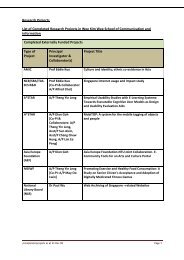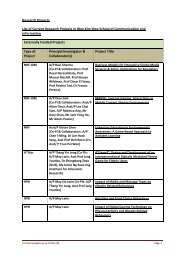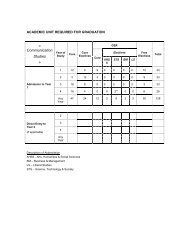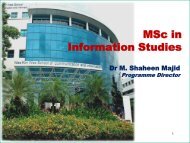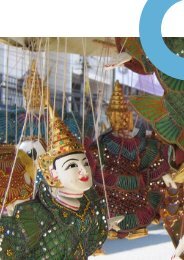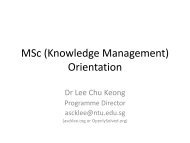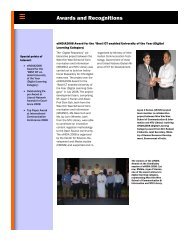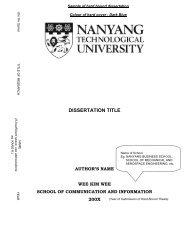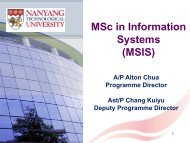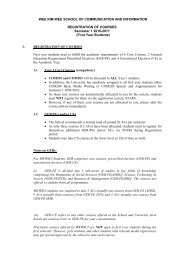Connexscions Volume VIII Issue 02 Jan - WKWSCI Home - Nanyang ...
Connexscions Volume VIII Issue 02 Jan - WKWSCI Home - Nanyang ...
Connexscions Volume VIII Issue 02 Jan - WKWSCI Home - Nanyang ...
Create successful ePaper yourself
Turn your PDF publications into a flip-book with our unique Google optimized e-Paper software.
CAMPUS<br />
Sojourning into<br />
Pyongyang<br />
Journalism students on a landmark practicum bond over<br />
blackouts, freezing temperatures and bizarre episodes<br />
When a group of final-year students won<br />
the chance to visit North Korea for a<br />
week last December for their Short<br />
Overseas Journalism (SOJOURN) module, they<br />
never imagined that the most newsworthy event<br />
would take place after they left. Eight days after they<br />
departed Pyongyang, North Korea’s supreme leader<br />
Kim Jung Il passed away.<br />
When the country’s gates closed to the outside<br />
world, final-year student Elizabeth Law thought to<br />
Supervisor Ms Hedwig Alfred (centre) giving a briefing on the<br />
bus<br />
by Amellia Razak<br />
herself, “Thank goodness we went there earlier. If not<br />
I’d be really annoyed.”<br />
The Straits Times ran a special feature on the group’s<br />
visit to Asia’s famously hermitic nation.<br />
“Honestly, it was very, very humbling,” said<br />
Elizabeth. “When you look at the other names in the<br />
newspaper, you know these people work hard for their<br />
bylines, but all we did was be at the right place at the<br />
right time, with the right person.”<br />
Each year, the journalism faculty allows a select<br />
few to venture overseas for its SOJOURN programme.<br />
Supported by the Wee Kim Wee Legacy Fund, the<br />
programme was created to give students the opportunity<br />
to hone their journalism skills in an environment<br />
unlike home.<br />
For the group of 16 final-year students on the<br />
practicum, being so close to an event that had a great<br />
impact on foreign relations between East and West had<br />
more personal implications.<br />
Despite the freezing temperatures, Elizabeth counted<br />
herself lucky to have walked the streets of Pyongyang.<br />
“It was about zero degrees and even though the<br />
walk was supposed to take only 45 minutes, we took<br />
nearly two hours and by the end of it, I could barely feel<br />
my face,” she said.<br />
To fourth-year student Foo Jieying, the sight of so<br />
much extravagance in a country with a meagre GDP<br />
was stunning.<br />
“You’d be surprised at how much North Korea tries<br />
to give off this perfect image, from multi-talented,<br />
plastic-smiled kindergarten kids to chandeliered ceilings<br />
in libraries and subway stations. For a country so poor,<br />
it’s amazing and shocking at the same time how they<br />
prioritise the flow of money,” Jieying observed.<br />
She has a new appreciation for the comfort of<br />
Singapore—how lucky we are to not have the frequent<br />
blackouts and desolate lands of North Korea.<br />
While she was in Pyongyang, Jieying was also<br />
unable to shake off the feeling of being watched.<br />
“There’s this talk about hidden cameras behind<br />
mirrors in the room and that possibility got some of us<br />
a little paranoid,” she admitted.<br />
That was not the only “creepy” feeling the students<br />
had during the week-long visit. Even a visit with<br />
kindergarten children gave the group chills, as the<br />
entire visit had an air of being overly staged and<br />
carefully executed.<br />
Elizabeth recalled their visit to a school where dead<br />
animals stuffed with cotton lined the corridors.<br />
“The teacher had a long stick which she would<br />
use to point at animals and the kids would shout their<br />
names, or point at the animals to answer the question.<br />
Since I was one of the photographers, I was standing<br />
quite near the front and the next thing I knew, a kid<br />
was grabbing me and shoving the stick into my hand!”<br />
While the children put on a performance for their<br />
visitors, they appeared to be capable of “turning on you<br />
fast”, Elizabeth observed.<br />
“One minute they’re welcoming you at the top of<br />
their lungs and the next, they’re laughing loudly at you<br />
for not knowing what ‘hedgehog’ is in Korean.”<br />
Regardless, stepping into a land steeped in history gave<br />
the group many learning points. North Korea is a cultural<br />
goldmine that outside eyes try hard to peek into.<br />
The group visited the Demilitarised Zone (DMZ)<br />
in Panmunjeom, even stopping at Mangyongdae, the<br />
birth town of Eternal Leader Kim Il-Sung.<br />
For the group, those precious few days will remain<br />
with them for a long time, not just because of the<br />
bizarre behaviour of the children, or the North Koreans’<br />
obeisance to their leaders, but rather, because of the<br />
bond the students developed with one another.<br />
“We were not allowed any gadgets other than our<br />
cameras and we didn’t have the chance to be plugged<br />
in (to the computer) or use our phones,” Jieying said,<br />
adding that as they only had each other for company<br />
and entertainment, “I think the bunch of us grew from<br />
strangers to pretty good friends in a week”. C<br />
A soldier paying respects at the site where the 1953 Armistice ending the Korean<br />
War was signed<br />
The brightly lit Pyongyang railway station at night<br />
The Sojourn team taking a photo with kindergarten children<br />
4 CONNEXSCIONS<br />
CONNEXSCIONS 5



